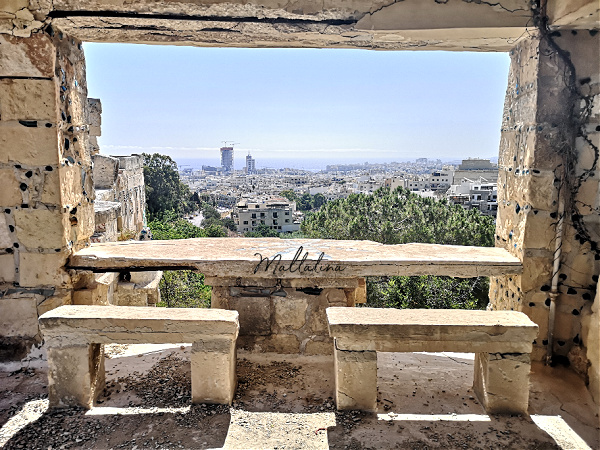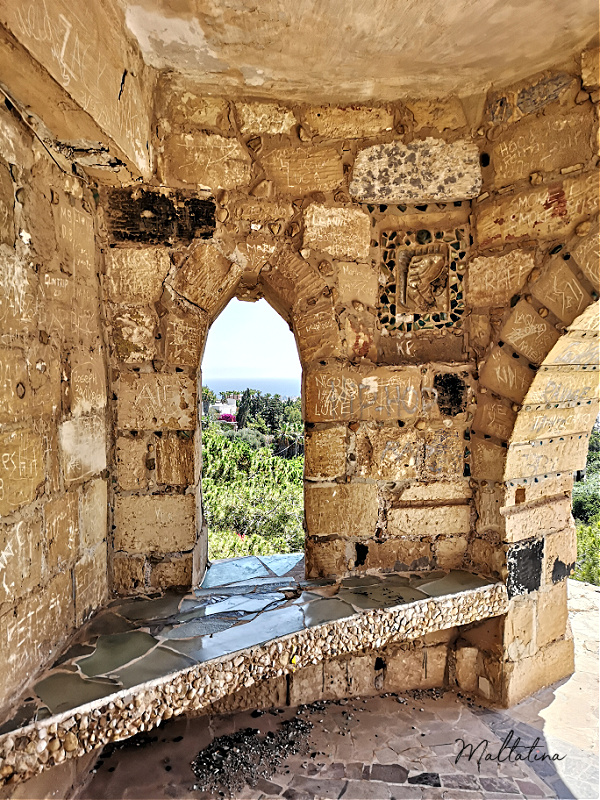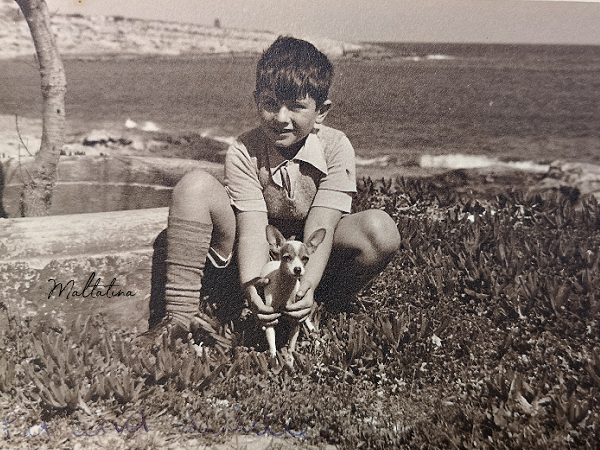The Mysterious Mystique: The True Story
I had a big dilemma if I should write this blog or not. If I publish it I’m basically openly admitting to trespassing. If I don’t, it feels like I’m hiding something beautiful and unique. At this point I would like to stress that people must not trespass and that the structure could be dangerous and should not be climbed.
Obviously, I’m not the first one to write about Mystique. There is a whole chapter dedicated to it in the 2018 book – Bizarre Malta – with a lot of beautiful images. When you look online, one of the first articles that comes up, upon ‘Googling’ Mystique, is a blog post from 2017. It doesn’t give much information, but what struck me the most was how damaged Mystique got in the last 3 years!

This is when I decided to publish this photo blog. The other reason, why I decided to go ahead is to correct a few facts about Mystique that have been published. I’ve interviewed many people, that is why it took much longer than any other blog I’ve ever written, including his two nieces; The Noble Romina Scicluna Marshall and Baroness Christiane Ramsay Scicluna (known as Muffy).
I’ve gathered so much information, that I don’t even know where to start. However, I think it best to start by correcting one of the most repeated inaccuracies that I’ve noticed. It’s not called ‘villa’ Mystique. It’s just Mystique. It’s a sculpture, not a building and it was never intended to be a residence or a ‘villa’. Therefore in this photo blog I will be correctly referring to this piece of art as Mystique.

I will analyze the architecture/sculpture of Mystique. Clarify a number of misinterpretations of Mystique related to it being a private residence, restaurant or even a night club. Last but not least I will dedicate a large part of this blog to the mind behind Mystique, Marquis Joseph John Scicluna and share few stories from his relatives and acquaintances.

Construction of Mystique
The construction of Mystique started in the early-1960s. Fantasy World, a book written by Deidi von Schaever and John Maizels Taschen in 1999 states that the works actually started in 1964. Unlike today, when the building work began, the surrounding land was all open country and Mystique had no neighbours.
The entire valley that stretches out below Mystique forms part of the story as it gives a wonderful view to the sea and was clearly a source of inspiration.

In Malta the mid-1960s were both exciting and challenging times for the arts. Artists were engaging in a soul-searching and at times, a rather elusive quest in search of a strong Maltese identity to be expressed by their respective mediums.
Marquis Joseph John Scicluna the 4th Marquis Scicluna, known by most as Joe, wanted to build a dream, a fantasy sculpture and going against a fairly restrictive upbringing, he was determined to express his more artistic and fluid personality through architecture.

Joe Scicluna salvaged pieces of stone, beautiful arches and various ornaments from the remains of the Maltese houses that were destroyed during World War II. Reclaiming them and giving them new life in his design.
Joe and two workers undertook all the construction work themselves. Joe liked to get ‘stuck in’, doing a lot of the physical work himself and not just directing from the side-lines. Sadly, it was never completely finished and Joe often liked to call it his ‘unfinished symphony’.

It has been said by the architectural community that; ‘There is no real reason, why this structure is standing because it denies all the rules of architecture. ‘They question how a man with no formal training could design and build such a place,’ concludes the Baroness.

Mystique: Architecture
Mystique is an original. You won’t find anything like it, in Malta. It is that kind of a building that makes you stop and wonder.
It qualifies as the only authentic architectural folly on the Maltese Islands. I like this definition of a folly: ‘An ornamental structure—often times strange, fantastical, or whimsical—built for just one purpose: pleasure.’ I think that’s exactly what Mystique is – a strange, fantastical structure built for the joy of the owner (and very often his friends) and something unique to remember him by.
The Palais Idéal du Facteur Cheval in France is another surreal construction, also built without the usual architectural rules.

Was there a plan? How was it built? Without doubt the designer, Joe, had a lot of imagination. Surrealistic imagination for sure and Mystique is the proof. He claimed that there was never a plan. He always gave ad hoc instructions, improvising and responding intuitively throughout the construction process.
The Marquis even told a few architectural students (visiting his property in early 80s) that he didn’t have a pre-determined design and could not care less for a building plan! Imagine someone saying that to the students of architecture today!

Mystique is decorated with thousands and thousands of colourful glass pieces. Most of them are rejected pieces from Mdina Glass. One of my readers shared with me that Joe used to go to the Mdina Glass workshop and collect all unwanted pieces.

I’ve exchanged a few emails with Architect Prof. Conrad Thake who sees Mystique as ‘a physical reminder that represents the triumph of a free human spirit unshackled by institutional conformity and societal order.’ Nicely said and I couldn’t agree more.
Another of my readers added: ‘Mystique does symbolise the artistic eccentricity of Joe Scicluna. Art for art’s sake, not function.’

One can spot the same coat of arms in different places at Mystique. The motto ‘Robur Genialitatis Praemium’ meaning ‘Strength is the price for joviality’ certainly emphasizes the philosophy of this eccentric and multifarious Marquis.

Stones of every shape and size were used for the construction. Mystique has an outlandish design and is split into two towers: ‘Mystic’ and ‘Mystique’. Each one has a character of its own, but are decorated in the same style. The tower closer to Triq Il-Pedidalwett is ‘Mystic’ and the other tower on top of the valley is ‘Mystique’.
Justine Pergola, Muffy’s daughter & Joe’s great niece remembers feeling like a princess in a fairy castle – ‘for a very little girl it felt like my own secret wonderland’.

Private residence or artistic hub
An article that I read related to Mystique stated that it was Joe Scicluna’s private residence. This is not completely true. According to Romina he didn’t even build it with the intention to live there but rather as a hub for artists. He wanted artists to go there – paint, play music, sing etc. Basically, create a safe place for the artistic community to meet.


The Baroness adds that it was more like his getaway place. ‘He would go and spend time at Mystique, but his official residences were the Dragonara Palace and Balluta Buildings and later in life he had an apartment in Palazzo Parisio’.
The World of Interiors Magazine 1989 edition confirms: ‘Mystique was made into an international club for artists and architects, where students could come to study and attend seminars.’
Mystique’s Private Parties & Club 47
There is a second misconception that surrounds Mystique – that is with regards to a venue back in the 80’s called Club 47. Even today people believe that Mystique and Club 47 were one in the same but this is not true. They were separate places for two different purposes.

Mecca of Jazz in Malta
Joe loved music, in particular he had a real affiliation with Spanish & South American music, following time he spent with his mother & siblings in Venezuela and he actively played several instruments, including bongos, guitar and maracas. Jazz sessions were taking place in Mystique every Sunday morning.
World class jazz musicians played and performed there. One such legend to mention is the ‘Queen of Jazz’ – Cleo Laine (who was a very good friend of the 4th Marquis) and her husband Johnny Dankworth. When Domenico Modugno came to perform in Gozo, Joe joined him in an impromptu jam session in Vittoriosa Square!

I would like to share a comment from one of my readers: “At that time Mystique was the place where local Jazz musicians were truly able to express themselves. Jazz was not appreciated elsewhere in Malta except for one club in Paceville, so Mystique became the Mecca of jazz in Malta.
It must have been truly magical to play and listen to Jazz music in those premises.
The future of Mystique
This quote from Goethe perfectly sums up the feelings of the Baroness who is the current custodian of Mystique; ‘Our future is to certain extent conditioned by our past, assuredly we have a responsibility to safeguard the tangible building legacy handed down to us.’

I published this photo blog in the fond hope that Mystique will be saved. Not only preserved but restored in a sensitive manner. Hopefully turned into a multi-functioning art hub as Joe Scicluna always wanted and his niece, Muffy and her daughter Justine are hoping to do just this.

The Marquis Joseph John Scicluna
The son of philanthropist Marquis Joseph John Scicluna (1903 – 1970) and Maria Violetta Testaferrata-Moroni-Viani, the 7th Baroness of Tabria.
Joe’s mother’s title – originally gifted by the Knight’s of St John – was recognised by the Queen of England and due to her title she could also sit on the Italian Senate, Baroness Violetta was even a guest at the coronation of Elizabeth II representing the Maltese nobility.
The current Baroness remembers her grandmother as ‘a fantastic woman’. ‘She would have been a great business woman had she been allowed to do it. She was a very jolly person and always up to something. As an accomplished pianist Violet would often organise parties in Dragonara Palace and during the war she would invite the officers of the British navy to join her for musical evenings, to keep spirits up’.

Joe – their 3rd child – was born in Dragonara Palace, which was the Scicluna’s residence at the time. He had three siblings, Corinne, Mignon and Patrick, all of them spent their childhood there at Dragonara Palace. They were all very protected from the ‘outside world’. The upbringing was strict and very religious as was the way in Malta at that time.
His school years cannot be claimed as a happy time for the young Joseph John. At the age of six he was sent to the Convent of the Sacred Heart and later boarded at St Edward’s College and spent a brief time at the Jesuit-run, St Aloysius College.

It seems to me that Joe Scicluna was like Michelangelo of his era. He was multi-talented artist. He loved and practiced sculpture, painting, music, photography and very interested in philosophy and science.
For many years he sat as a Director on Farsons’ board and Muffy remembers that ‘He was fantastic. He would bring up all these ideas and always be sharing anecdotes. At that time he was considered to be a colourful addition to the Board, and today everyone affectionately remembers those days as fun times.’
Joe Scicluna never married and remained a bachelor all his life. One thing is for sure Joe Scicluna loved women and their ‘shapes’. He enjoyed their company and would often ask them to sit for portraits – sometimes painted, sometimes photographed.
What was Joe Scicluna like?
Joe Scicluna was mostly seen in army shorts. He had an obsession about the military and medals. It was his fantasy. He just loved it. Some of his uniforms are still stored at Palazzo Parisio.

I kindly asked Romina to describe her late uncle. ‘Joe was charismatic, charming, intelligent, and creative with a great sense of humour. He was a great story teller. He was very knowledgeable and interested in everything.’
‘The marquis was an imposing figure in terms of stature but he exuded a pleasant personality without any airs and graces. He was also quite eccentric and quirky.’ – this is how Prof Conrad Thake remembers Marquis Joseph Scicluna when he met him in 1983 as a second years architecture University student at Mystique.

‘My uncle was a fantastic creature with a wicked twinkle in his eye. He was a lovely person and everybody loved him. Unfortunately, his eccentricity meant that he was often misunderstood for many years. Sometimes people are only really appreciated when they’re gone. I admired him immensely.’ – Baroness Christiane Ramsay Scicluna.
Justine remembers: ‘I used to be fascinated by him. He had a lot of time for me & I liked to be with him because he was a bit different and so cool. He was a very inspirational man. I enjoyed his company very much.’
Buried in Mystique
The last five years of his life he spent in Rome with his sister Corinne, Christiane and her husband, Umberto and their daughter Justine. He was already very sick at that time, so he had someone to take care of him.

The last wish of Joe Scicluna was to be buried in Mystique. ‘When I die, I’d like to be buried in Mystique, not in a cemetery. We have our own private chapel in the cemetery, but I’d rather be buried where I built, because that’s part of me.’ he had revealed in the interview by TVM/ABC (Australia).
Unfortunately, his wish was not granted as on 6th June 1995, he died in Rome and was buried in the Scicluna family’s private chapel in the Addolorata Cemetery.
He might not be buried in Mystique, but as he said in one interview: ‘As I have no children, I am leaving Mystique and Mystic to my niece so that she might be able to continue my legacy and give young Maltese architects a broader education, exploring the possibilities of free form architecture and architecture as sculpture.’


I would like to finish off with a short virtual tour of Mystique.
Author’s note: This will be most likely an ongoing research. The article might be amended from time to time to make it even more accurate.




This is one of my favourite blog you wrote so far. It is so well researched and immensly intersting. Well done – keep them coming Tina
Thank you so much! Really appreciate it. Tina x
My mum was a friend of Joe’s. I remember going there a number of times as a child. I have photos of it from back in the 70’s. Incredible place.
I am very glad to see this how can i visit pls to spend some peacefull time ?
Hi Georgina, unfortunately Mystique is a private property and it’s closed to the public. Hopefully that will change one day and everyone will be able to come in and admire the beauty! 🙂
Very curious, interesting and inspiring. I have been knowing about this place from early 70’s
My dad was part of the crew that helped build/maintain the property in the later stages—in the early early/mid 70s. He also helped run many of the large parties/gatherings that took place there. My dad sometimes brought me along to the Mystique (I was around 9 years old at the time) and I remember wondering the gardens/structures in awe. I also visited Palazzo Parisio and met the Marquis on many occasions. He used to call me “l’avukat” because he said I always had a ready answer to whatever question he posed. He was always very kind and congenial towards me, often sending me to the store to by milk for his Doberman and telling me to “keep the change” when I returned. I have such wonderful memories of both the man himself and the fantastical property he built. RIP Sue Joe
Wow! Thank you so much for this! So very interesting! I went to Mystic in 2019, such an amazing beautiful magical place, wish it was open to the public. Hopefully one day! 😊
I had the chance to go in Mystique once..I remember a big bronze bowl in the middle of the yard..i was impressed ..I remember a strange party held there.I was young, I attended Vibes Disco and went for a walk with some friends…we ve passed near this house and there was an opened door,looked in and saw a party going on. One guy, dont know who he was, called us and asked me if I need something. He also said that its not the right place for us. After I went on my own again and had the chance to go in and showed me around.
What and how can be done to save and protect the villa? Who should be contacted?
Well it’s privately owned, so unless the owners decide to restore/preserve it, there is nothing that can be done I’m afraid..